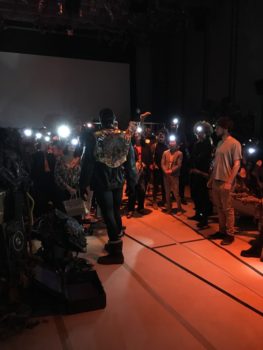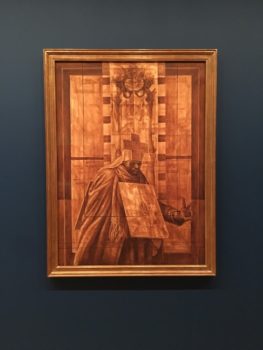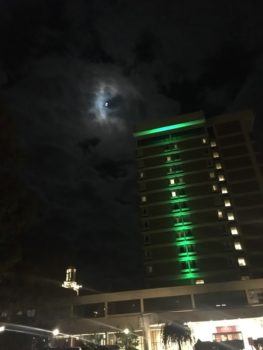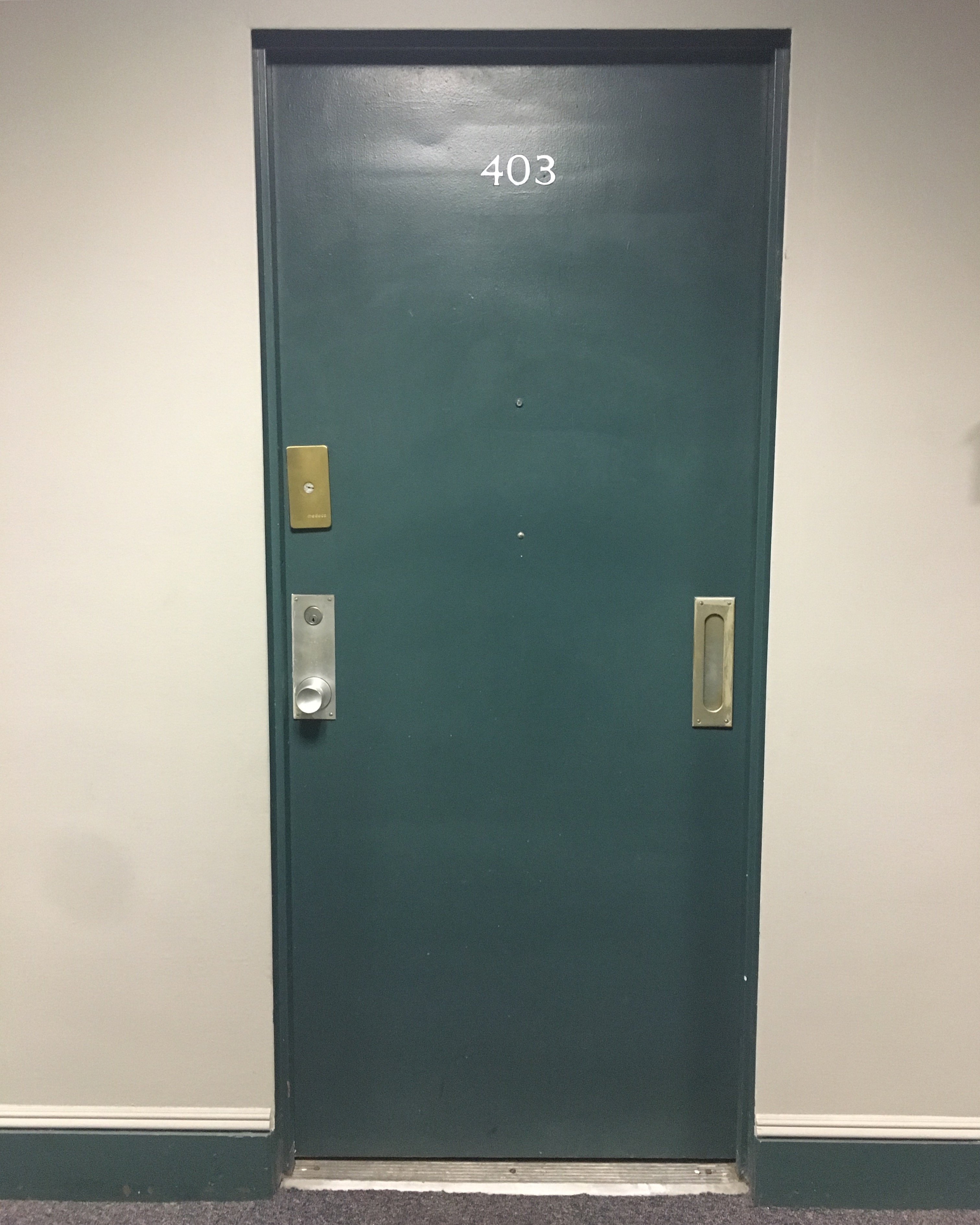[ad_1]

Room 403 at the former home of the St. Denis hotel near Union Square, once the secret studio of Marcel Duchamp, temporarily used for an installation by Serkan Ozkaya by Postmasters.
The long, rich tradition of running galleries in apartments—and even more obscure locations—endures in New York, and one of the more interesting in the genre is the Middler, run by Anthony Atlas, whose day job is with the estate of William N. Copley (a.k.a. CPLY). On the first of the month, he fills his apartment in Ridgewood, Queens, with people for a one-night display of videos by Reid Urban. I arrive for the second screening, only to find out that the devoted fans all came for the first screening, an hour earlier. Still, it’s nice to see Sam Franklin, Bryce Grates, Quintessa Matranga, and Atlas, who is kind enough to send me digital files of Urban’s off-kilter videos.
The next day, I am at 80 East 11th Street, the former home of the St. Denis hotel, where Ulysses S. Grant worked on his memoirs, where Abraham Lincoln once slept, and where Marcel Duchamp completed his final work, Étant donnés, in secret. It is the 49th anniversary of Duchamp’s death, Magda Sawon, co-owner of Postmasters, informs me when we meet there. She has taken number 403, the room used by Duchamp, and installed a 3D-printed version of his piece created by artist Serkan Ozkaya, who theorizes that the installation can be used as a camera obscura. Ozkaya has placed a light within the installation so that it shines through the peephole out into the room, and claims that it presents the outline of Duchamp’s alter ego, Rrose Sélavy. I see no such thing, but I do spot what appear to be abstracted Greek ruins, or maybe a skull, and the idea of other mysteries lingering in the most mysterious of all 20th-century artworks is fun to ponder.

Abigail DeVille’s Empire State Works in Progress (2018) at the Whitney Museum.
On the evening of the 14th, I head to the Whitney for a performance by Abigail DeVille titled Empire State Works in Progress. It’s in the museum’s auditorium, which is close to pitch black. After being warned about sharp objects, we are handed a miner-style flashlight to strap onto our heads. Inside, there are characteristically excellent assemblages by DeVille—big, hulking tangles of metal, piping, wire. A little dangerous, very sexy. A band of musicians lead the performance, and it is stunning: an Afro-Futurist world of wrecked machines, where songs—art—provide a way forward. “Where there’s a will there’s a way,” one singer intones slowly, forcefully. At one point, a singer is stepping backward, rhythmically, around the perimeter of the room, and around the installation, the bassist (with a wireless electric bass) follows him, facing forward, moving in the same shuffle. Their feet are keeping the beat. [Video]
One of the odder happenings of late has been the steady takeover of two Chinatown malls underneath the Manhattan Bridge by art types. In the basement of 88 East Broadway, the Jeffrey Stark gallery operates out of a little white-cube kiosk, alongside jewelers, antiques sellers, and noodle shops, and its shows are visible from 10 a.m. to 9 p.m., seven days a week. At the start of the season it’s showing Aleksander Hardashnakov, who presents modestly sized works on paper that hold little figures made out of matchsticks, plus a mobile made from a splayed can of Canada Dry club soda, newspaper, and the like—very in line with the enduring trend of humbly hand-fashioned sculpture.
Across the street, on the second floor of 75 East Broadway, home mostly to clothing retailers, the London-based gallery Tramps and powerhouse Michael Werner are showing an attractive set of works by Lotte Maiwald, which put me in the mind of a more-sincere Neil Jenney. That’s around the corner from the record album and bookstore 2 Bridges Music Arts and another kiosk space called Vitrine, run by Werner, which shows one work at a time. When I stopped by on a Sunday afternoon in September, a Peter Saul painting that stars George W. Bush and Hitler in a kind of animalistic airplane is on view. Peter Doig, who recently had the party for his new Werner show at the dim sum restaurant at the mall across the street, happens to be wandering around.

Charles White, Black Pope (Sandwich Board Man), 1973, in “Charles White–Leonardo da Vinci. Curated by David Hammons” at MoMA.
This is also the month of David Hammons. At the Museum of Modern Art we are presented with “Charles White—Leonardo da Vinci. Curated by David Hammons,” which features a Leonardo of a kneeling figure borrowed from the Queen of England and an incredible painting by White of a street-based religious leader, outfitted in a pope hat and cardboard sign. Astrology charts are free for the taking, analyzing the two artists. (The morning I swing by, art reporter Judd Tully, who is working on a documentary about the reclusive Hammons, is there taking notes.) All in all, it feels like a winning display about various forms of power and ways of occupying space. The Whitney also reveals schematics for a public artwork that Hammons is proposing for the water near the museum—a skeletal metal outline of the long-vanished pier building that Gordon Matta-Clark once sliced into. Here’s hoping it gets approved and built.
I spend much of the month catching up on season-opening shows that I missed in September (with a brief pause to speak with energetic, refreshingly unjaded first-year students in a class taught by Isolde Brielmaier at NYU). Among the most immediately memorable exhibitions are a John Chamberlain solo at Gagosian uptown of captivating masks that he made quietly and which were unknown to me, and, at the FLAG Art Foundation, an Ashley Bickerton retrospective that looks very, very fresh. It’s slick and smart and perfectly in tune with the high-gloss, big-money psychosexual dynamics of 2017 America. Someone get this guy a museum retrospective!
The most divisive show may be artist and fashion designer Susan Cianciolo’s long-term stand at Bridget Donahue, where she hosts book-making classes, performances, and a little café. It’s too precious, or even twee, for some, but I welcome the hospitality and community vibe, and very much enjoy a potent matcha cookie and hot tea when I visit. Also on the fashion front, I stop by Sterling Ruby’s shockingly yellow Calvin Klein showroom and find, just across the street, the Louis Vuitton Jeff Koons Masters Collection shop, which has many mirrors and handbags, scarves, and other accessories printed with famous paintings. The Gauguin merchandise—of a topless woman—is really something.

Installation view of “Nicola L.: Works, 1968 to the Present” at SculptureCenter in Long Island City, Queens.
Other shows seen: Jef Geys’s second show of the year, this time with wrapped paintings unsold from his outing in the spring at Essex Street; Nicola L.’s humanoid furniture and “penetrables” (SculptureCenter), David Salle’s anemic latest works (Skarstedt); Jacob El Hanani (Acquavella Galleries); “Three Dimensions,” which features a quite erotic fabric sculpture of a Silex juice-making machine from 1965 with the superb title Soft Juicit—”Ghost” Version (Acquavella); a sterling outing by Doig (Michael Werner); John Ahearn / Rigoberto Torres and Peter Hujar (Alexander and Bonin); Neal Jones (Maccarone); Suzan Frecon (Zwirner); parts of “October Burst,” an array of one-day shows and performances (Bureau Gasser); Yang Jiechang (Chambers Fine Art); boring little Ding Yi paintings (Timothy Taylor); Barbara Chase-Riboud’ great “Malcolm X” sculptures (Michael Rosenfeld); Rudolph Burckhardt / Edwin Denby (Bruce Silverstein); William Hawkins’s exuberant paintings (Ricco/Maresca); Fernanda Fragateiro (Josée Bienvenu); au courant Andrew Ross sculptures in the first show in Chelsea from the Bed-Stuy-founded American Medium; “The WPA” (Washburn Gallery); Agnes Denes (Leslie Tonkonow Artworks + Projects); Tanya Marcuse (Julie Saul Gallery); a wan Aurel Schmidt affair (P.P.O.W.); John Graham (Allan Stone Projects); a touching Joyce Kozloff exhibition with wall pieces incorporating a variety of maps and childhood works by the veteran artist (DC Moore); Robert Motherwell (Paul Kasmin); Anthony Caro and Jules Olitski (Kasmin); and “The Enormity of the Possible,” stacked with American modernist gems by Marin, Avery, Nadelman, and more (Kasmin); Sun Xun and weak Iran do Espírito Santo sculptures of screws (Sean Kelly Gallery); Brian Calvin and Mike Kuchar (Anton Kern Gallery); “Camerado, this is no book” (Pratt’s DeKalb Hall Gallery), which unites alums like Robert Mapplethorpe, Marilyn Nance (a legendary figure but a new name for me), Robert Wilson, and my friend Rose Marcus, whom I’m thrilled to run into at the opening.

A work by Lee Bontecou and Marcia Marcus, Obituary (Bob Thompson), 1968, at Firestone Loft.
Also: “Untitled Passage” (Housing, a promising new gallery in American Medium’s former home); Joshua Abelow and Steve Keister (Real Estate, a Greenpoint space that is used primarily as a—you guessed it—real estate office); snazzy Graham Collins paintings stitched together from thrift-store finds (The Journal); scrappy collages and drawings by Lois Lane (Southfirst), who is on hand with the gallery’s free-thinking owner, Maika Pollack, who is just back from Frieze London; pristine, creepy sculptures by Elizabeth Orr (Bodega); Ellie Ga (Bureau); remarkable portraits of Bob Thompson, friends, and family by Marcia Marcus, who is set to turn 90 in January (Eric Firestone Loft); typically pleasing, albeit predictable, work by both William Wegman and Tom Sachs (both at Sperone Westwater); high-production-value hanging sculptures by Kathleen Ryan (Arsenal Contemporary); Elizabeth Price and William Monk (Grimm); next-level still lifes by Holly Coulis (Klaus von Nichtssagend); “The Overworked Body: An Anthology of 2000s Dress” (Ludlow 38 and Mathew Gallery), which is a feast of recent fashion history; “Ferus Gallery: Between the Folds,” with classic posters and ads for and by Ruscha, Lichtenstein, and many more (Alden Projects); spare, urbane Robert Moskowitz paintings honoring classic New York buildings (Kerry Schuss); “Anonymous Tantric Paintings” (33 Orchard); the always excellent Rosemarie Trockel showing wild ceramics (Gladstone 64); impressive Paulo Nazareth sculptures with found objects (Mendes Wood DM); “A Different Medium” (Rosenberg & Co.); a moving and weird Keith Edmier show with his famous sculpture of his mother nine-months pregnant with him, surrounded by 50 life-casts of everyone from Alfred Hitchcock to Michael Jackson (Petzel); an ambitious Alexander Tovborg doubleheader with small painting sets that suggest almost-abstract religious icons and a huge frieze that could fill a chapel (Blum & Poe and Nicelle Beauchene); Mira Schendel (Hauser & Wirth); too-refined glitchy Evan Nesbit paintings (Van Doren Waxter); awesome early Mary Heilmanns (Craig F. Starr Gallery); sumptuous, Pattern & Decoration–style Lauren Luloffs, with stitched, bleached, and printed fabric (Ceysson & Bénétière), which resemble a bit the work of Robert Kushner, whose name I spot in the guestbook just above mine.

Installation view of “Keith Edmier: Mother Mold” at Petzel.
And even more: the once and future king, Jack Goldstein, whose films are being projected digitally, beneath empty film projectors (Venus Over Manhattan); Sheila Pinkel (Higher Pictures); Walter De Maria (Gagosian Park & 75); stunning lunar symbolism by Alastair Mackinven (Reena Spaulings); Saira McLaren (Sargent’s Daughters); David Levine delivering a tender, wry portrait of his father, who was involved in the Marlborough-Rothko scandal (83 Pitt Street); super-funky, impressive Alex Chaves paintings (Martos Gallery); an odd, sort of mannered Sojourner Truth Parsons outing (Downs & Ross); exemplary Emily Mae Smith Surrealist works (Simone Subal); Matt Connors (Canada); “Working/Not Working” (Canada); Dominick Di Meo, who is new to me and a complete revelation (JTT); Lonnie Holley (James Fuentes); hard-edged Don Dudley paintings with subtle undertones of delicate improvisation (Magenta Plains); “The Middle,” curated by Michael Buhler-Rose and John Connelly (Johannes Vogt); “Social Surfaces” (Artists Space, Bortolami, Alexander & Bonin, Pearl River Mart); Jordan Casteel (Casey Kaplan); “L.A. Invitational” (Gagosian Gallery); Peter Saul (Mary Boone Gallery); Cary Smith (Fredericks & Freiser); Liz Magor and Michael Blazy, Piero Gilardi, Tetsumi Kudo, Anicka Yi (Andrew Kreps); Ryuji Tanaka (Simon Lee); Ry Rocklen (Team); Marcel Broodthaers and James Lee Byars (Marian Goodman); Jeff Sonhouse (Tilton).
The month ends with disturbing news. Knight Landesman, the long-running, omnipresent co-publisher of Artforum resigns amid allegations of sexual harassment levied by a former employee, Amanda Schmitt, and others. Word breaks that editor Michelle Kuo filed a resignation letter earlier in the month, over the business side’s handling of the issue. Rumors are in the air about the behavior of other prominent men.
Art and art fairs feel ridiculous at the moment, but the calendar keeps chugging. The second edition of TEFAF Fall (Park Avenue Armory)—the Maastricht-headquartered affair known for its copious offerings of oysters, champagne, and flowers—runs at the Park Avenue Armory near the end of the month. Bernard Goldberg Fine Arts brings a trove of Nadelman sculptures—best in show in my book, though it’s hard to choose in an event overflowing with fine weapons, objets d’art, Old Masters (a Delacroix tiger via Paris’s Galerie Eric Coatalem, for instance), and more.

Jimmy Robert performing Imitation of Lives at the Glass House in New Canaan, Connecticut, on October 31, 2018, with a work by Lucy McKenzie, at right, and, at left, another version of Elie Nadelman’s Two Circus Women.
Performa—RoseLee Goldberg’s performance-art biennial—is scheduled to run for the first three weeks of November, and on the 31st, I venture to the Glass House in New Canaan, Connecticut, to see a preview of Jimmy Robert’s piece, Imitation of Lives, organized by Charles Aubin and Cole Akers. Roberts and two other black dancers, NIC Kay and Quenton Stuckey, transfix the guests for an hour, moving through and around the famed structure and paintings by Lucy McKenzie and Poussin. Wearing various guises, they watch each other, and watch themselves being watched. It’s a poetic master class in how history and architecture shape what can be seen—what is visible. Ornette Coleman and Brahms play through speakers and at one point a voice intones, “In the ’30s Philip Johnson, who built this house, had a brief relationship with Jimmie Daniels, the cabaret singer from Harlem. Jimmie wrote a song titled: ‘Chez moi’—At mine.”

Night in Pittsfield, Massachusetts, outside the the Crowne Plaza.
I could stay on those sun-dappled grounds all day, but over the past few weeks, the Berkshire Museum affair has heated up. The three sons of Norman Rockwell have filed suit to stop the controversial sell-off and members of the museum have filed their own brief aiming to scuttle it. The first hearing in the case is scheduled for the next day in a Pittsfield courtroom, so I leave right after the performance to catch a train to Port Chester, New York, to pick up a rental car and drive north. By the time I get to the city of about 43,000, it’s night and the streets are quiet. My hotel has Hogwarts banners in its lobby, for some unknown reason. The top story in the Berkshire Eagle available there mentions the latest development in the saga: Massachusetts Attorney General Maura Healey entering the fray, asking that the auctions be halted so that her office can study the museum’s proposal. “Healey joins call to halt art sale,” the headline reads.
[ad_2]
Source link

